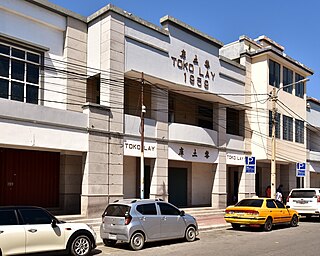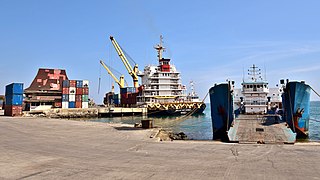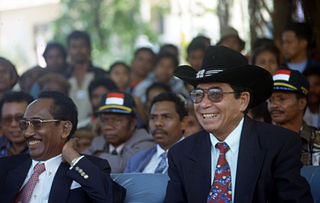
Timor-Leste, officially the Democratic Republic of Timor-Leste, is a country in Southeast Asia and Oceania. The country comprises the eastern half of the island of Timor and the nearby islands of Atauro and Jaco. The first inhabitants are thought to be descendant of Australoid and Melanesian peoples. The Portuguese began to trade with Timor by the early 16th century and colonised it throughout the mid-century. Skirmishing with the Dutch in the region eventually resulted in an 1859 treaty for which Portugal ceded the western half of the island. Imperial Japan occupied East Timor during World War II, but Portugal resumed colonial authority after the Japanese surrender.

The Revolutionary Front for an Independent East Timor is a centre-left political party in East Timor. It presently holds 19 of 65 seats in the National Parliament. Fretilin formed the government in East Timor until its independence in 2002. It obtained the presidency in 2017 under Francisco Guterres but lost in the 2022 East Timorese presidential election.

East Timor was a province of Indonesia between 1976 and 1999, during the Indonesian occupation of the country. Its territory corresponded to the previous Portuguese Timor and to the present-day independent country of East Timor.

Same is a town in the Same administrative post in the interior of East Timor, 81 kilometres (50 mi) south of Dili, the national capital. Same has a population of 7,413 and is the capital of Manufahi municipality, which was known as Same District in Portuguese Timor.

The Indonesian invasion of East Timor, known in Indonesia as Operation Lotus, began on 7 December 1975 when the Indonesian military (ABRI/TNI) invaded East Timor under the pretext of anti-colonialism and anti-communism to overthrow the Fretilin government that had emerged in 1974. The overthrow of the popular and short-lived Fretilin-led government sparked a violent quarter-century occupation in which approximately 100,000–180,000 soldiers and civilians are estimated to have been killed or starved to death. The Commission for Reception, Truth and Reconciliation in East Timor documented a minimum estimate of 102,000 deaths as a result of the conflict in East Timor during the period 1974 to 1999, as well as a large part of the consequences of Indonesian war crimes during the invasion of Dili, including 18,600 violent killings and 84,200 deaths from disease and starvation; Indonesian forces and their auxiliaries combined were responsible for 70% of the killings.

The Indonesian occupation of East Timor began in December 1975 and lasted until October 1999. After centuries of Portuguese colonial rule in East Timor, the 1974 Carnation Revolution in Portugal led to the decolonisation of its former colonies, creating instability in East Timor and leaving its future uncertain. After a small-scale civil war, the pro-independence Fretilin declared victory in the capital city of Dili and declared an independent East Timor on 28 November 1975.
Alas is a town in Alas Administrative Post. It is located in the interior of the island, 294 metres above sea level. As the crow flies, Alas is 56 km southeast of the state capital Dili and 7 km to the east of Same.
Rosa Filomena "Muki" Cardoso Bonaparte Soares was an East Timorese revolutionary and women's rights activist. Born in what was then Portuguese Timor, in 1973 she won a scholarship to study in Portugal, where she joined the Casa dos Timores and became involved in Marxist and anti-colonial politics. Returning to Timor in late 1974, she was a founding member of Fretilin and served on the party's central committee. Known for her intensity and small figure, she was called "the petite revolutionary", "Rosa Luxemburg", and to her Fretilin comrades, "Muki".

The Berloi Waterfall is a small waterfall in the municipality of Aileu, East Timor. It forms part of a minor tributary of the Comoro River.

The East Timor genocide refers to the "pacification campaigns" of state terrorism which were waged by the Indonesian New Order government during the Indonesian invasion and occupation of East Timor. The majority of sources consider the Indonesian killings in East Timor to constitute genocide, while other scholars disagree on certain aspects of the definition.

Toko Lay is a commercial building in the centre of Dili, East Timor.

The Kraras massacre was a series of mass killings committed by the Indonesian Army, along with Timorese Hansip members, in August and September 1983 in Kraras, Viqueque Municipality, East Timor. More than 200 civilians, mostly men, died in the killings. The region is now known as the "Valley of Widows".
The Indonesian invasion of Dili occurred on 7 December 1975 when Indonesian marines and paratroopers landed in the East Timorese capital of Dili. The attack was the start of a military operation which resulted in the Indonesian occupation of East Timor.

The Port of Dili is a seaport in Dili, East Timor. Prior to 30 September 2022, it was the main and only international port of entry to East Timor. On that day, its container operations were transferred to the Tibar Bay Port. Since then, the Port of Dili's facilities have been open only to domestic passenger ships and cruise ships carrying international tourists.

The 1975 Council of Ministers was the Council of Ministers formed by the Fretilin political party in 1975 as the inaugural administration or cabinet of the Democratic Republic of East Timor proclaimed in November 1975.

The Government Palace in Dili, the capital city of East Timor, is the official workplace of the prime minister and Constitutional Government of East Timor. In the final stages of the Portuguese colonial era, it was known as the Official Palace, and was the office of the colonial governor.

João da Costa Tavares was the Commander-in-Chief of the pro-Indonesian Militia in East Timor. He was also a pro-integration militiamen.

The Democratic Republic of East Timor, was a state that was unilaterally proclaimed on the territory of present-day East Timor on 28 November 1975 by Fretilin prior to the Indonesian invasion of East Timor nine days later on 7 December 1975.
In August 1975, a civil war broke out between two opposing political parties in Portuguese Timor: the conservative Timorese Democratic Union (UDT) and the left-leaning Revolutionary Front for an Independent East Timor (Fretilin). The war took place within the context of decolonisation, as the post–Carnation Revolution Portuguese government sought to give independence to much of the Portuguese Empire. UDT and Fretilin were formed in May 1974, following the legalisation of political parties in Portugal. UDT initially advocated for continuing ties to Portugal, before shifting to promoting a gradual independence process that maintained existing institutions. Fretilin sought independence with a new political system that would address a widespread lack of development in the territory. Also formed during this time was the Timorese Popular Democratic Association (Apodeti), which advocated for an Indonesian annexation of the territory, although Apodeti gained far less popular support than the other two major parties.


















